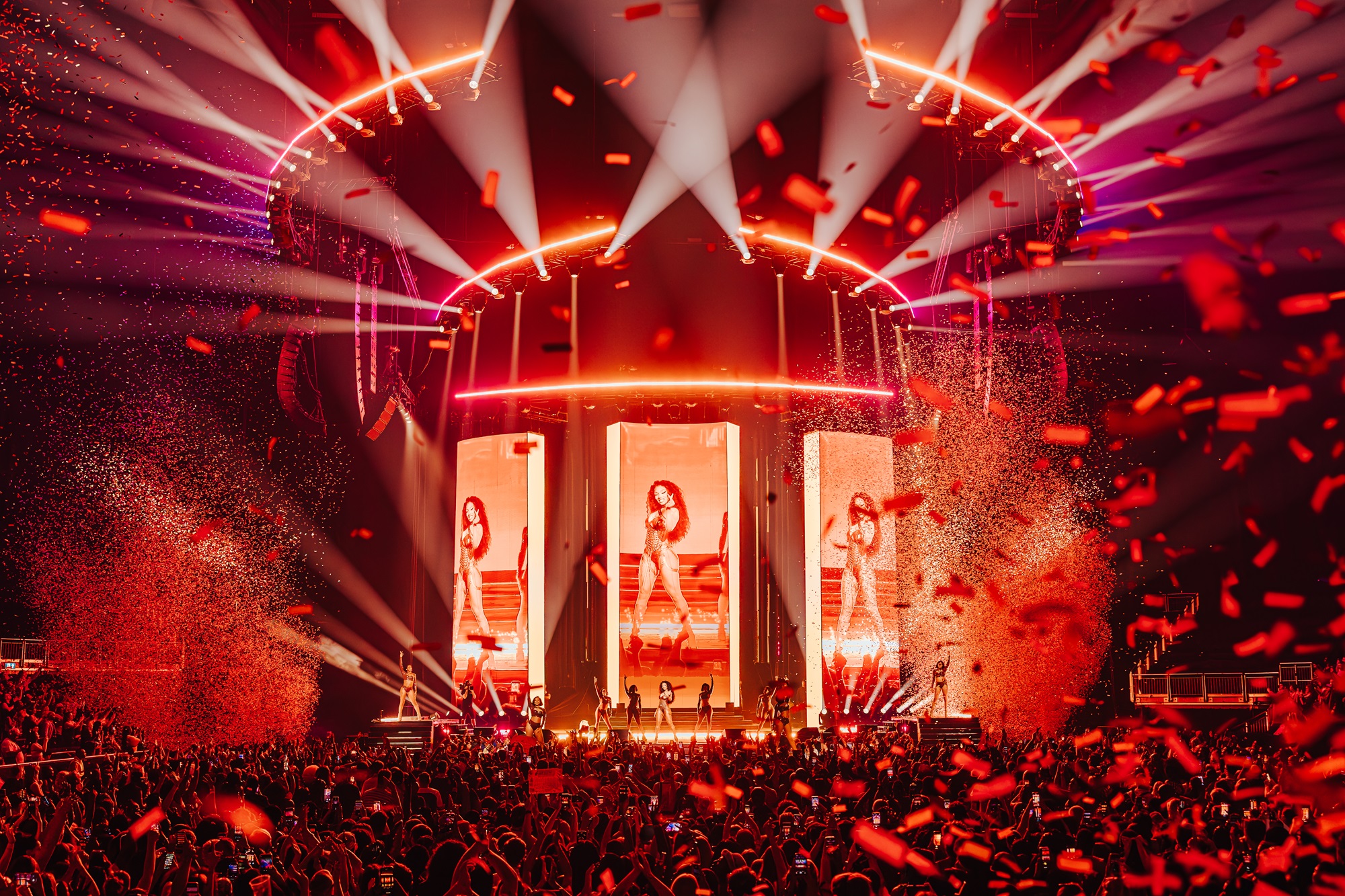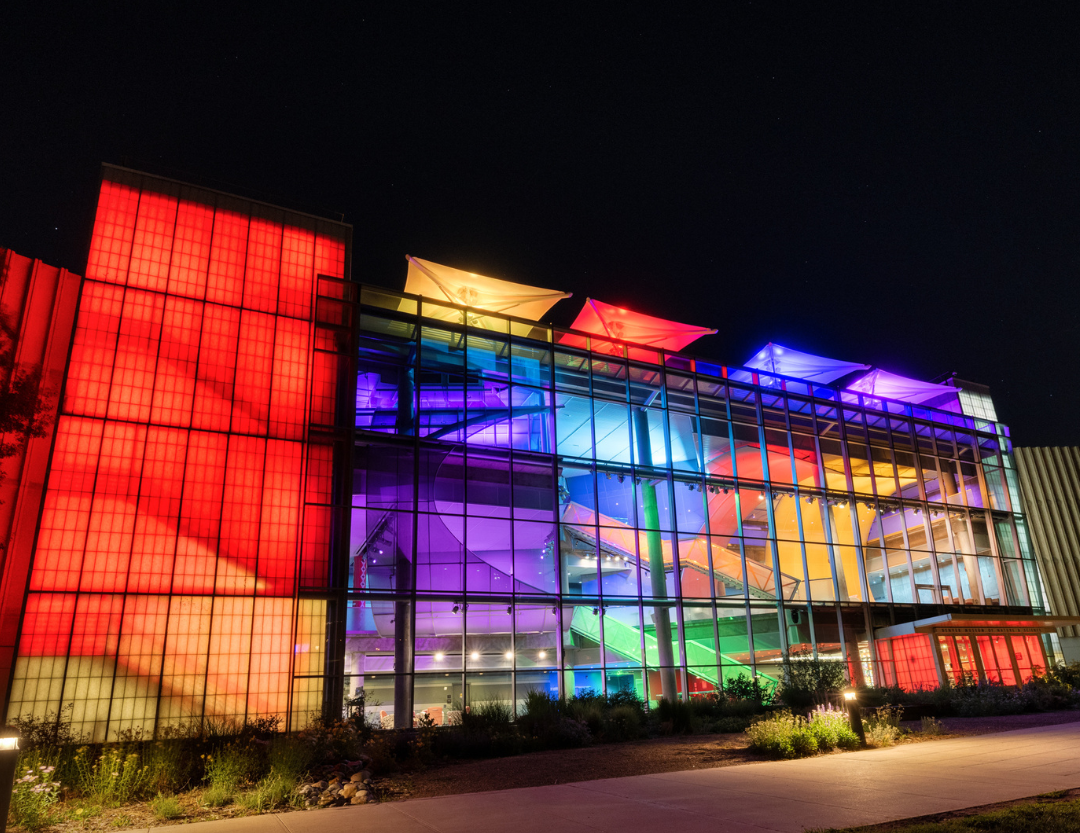NEW YORK — Fashion Week once again brought a variety of lighting designers and show producers to venerable New York landmarks, but one of Scharff Weisberg’s most impressive projects this year was on a vacant lot on the corner of 30th Street and Tenth Avenue: a temporary, three-story white building, used for a multi-million dollar bash thrown to mark Calvin Klein’s 40 years in business, which also served as a benefit for New York’s Highline urban redevelopment project. Guests entered the temporary building from the Tenth Avenue side to an open space with a grand staircase that led to a bar on the second level and provided access to the Highline, the name for a pedestrian walkway and park that is using the structure left over from an abandoned elevated railway. Estelle performed on one of the first completed sections of the project. After the party, the building was dismantled and its parts donated or reused.
Scharff Weisberg provided JKLD with an ETC conventional lighting and dimming package for all the rooms in the building, and also for the Highline level. “It’s always a welcome challenge working with JKLD on their many creative projects, but the Calvin Klein anniversary party in particular was an amazing project both in size and scope,” said Terry Jackson, Scharff Weisberg project manager. “It raised the bar for what was expected of parties during Fashion Week.”
Scharff Weisberg also furnished a pair of Barco FLM 18 projectors, which lit up a billboard adjacent to the venue. KCD teamed with Calvin Klein on that projection, which consisted of slipcovering an existing 40-foot-by-30-foot billboard, showcasing images from Calvin Klein ad campaigns. The source was a QuickTime movie played via laptop through a switcher, Barco Encore controller and ScreenPro II, all provided by Scharff Weisberg “It was somewhat simple but very impactful,” noted KCD’s Keith Baptista.
Other venues where Scharff Weisberg’s crews were busy during Fashion Week had a higher profile than just a vacant lot. They included the Park Avenue Armory, the Lexington Avenue Armory, the New York State Theatre at Lincoln Center and the New York Public Library.
The large G-Star Runway show at the Uptown New York 7th Regiment Armory on Park Avenue, which was produced by Dizon Inc. with Sightline Productions acting as lighting and sound designers, posed a considerable challenge.
The main rig consisted of 300 moving lights comprised of Vari*Lite VL3500s and VL3000s and Martin Mac 700s plus conventional ETC and Thomas fixtures and dimming with a grandMA controlling the eight-universe show. Scharff Weisberg also furnished ARRI fresnels and soft lights for hair and makeup backstage.
Scharff Weisberg also worked on the G-Star after party, in the Armory’s officers chambers. The company provided a UPA audio system and bar, DJ, product and performance lighting throughout the space to enhance the building’s architectural details. The lighting package of LEDs, ETC Profiles and PARs, ARRI soft lights and fresnels illuminated multiple historic rooms and the Drill Hall Entrance.
Scharff Weisberg was also challenged to supply lighting to the Proenza Schouler show at the Armory. This fashion show, which was loaded into the venue simultaneous with the G-Star load in, required that a 660-foot runway lit from ground-supported towers be installed overnight. Scharff Weisberg furnished Thierry Dreyfus Lighting Design with a dozen Robert Juliat followspots on four independent towers along with ETC and ARRI front light and back light towers. Jonathan Goldstein also worked with Dreyfus on the lighting.
Scharff Weisberg reteamed with Thierry Dreyfus to provide full production support for his design of the Tommy Hilfiger show in the Upper and Ticket Lobbies at the New York State Theatre at Lincoln Center. The company supplied an ETC conventional lighting and dimming package that Dreyfus used to light the gold leaf-covered ceiling and bathe the space in a golden glow that matched the custom-built hardwood runway and bleacher seating.
Gayle Dizon and Kirsten Nash of Dizon Inc. produced the event with Tim Darwish serving as technical director.
For the fourth consecutive season Scharff Weisberg also provided JKLD with full lighting support for the Marc Jacobs show. Produced by KCD, the event transformed the Lexington Avenue Armory with hanging mirrors casting a multitude of reflected images of the parading runway models.
Scharff Weisberg also supported a number of smaller fashion shows during Fashion Week, including gear supplied to Design One Corporation for the Derek Lam fashion show at Terminal Stores, where Regan Dodson served as production electrician.
Scharff Weisberg also provided JKLD with equipment for the Malo show at the New York Public Library where Andrew Merriweather and Nathan Winner were the production electricians.
The company also supplied Number Nine Design with a package for the Vivienne Tam show at 40 Mercer Street. Andy Muller was the video and audio project manager there.
Scharff Weisberg supplied lighting and audio gear to BaD Lighting’s Barrett Hall for the Zero + Maria Cornejo runway show for that company’s retail store at 33 Bleecker Street, where a FOH truss goal post was outfitted with an array of Source Four lenses illuminating the runway.
The Scharff Weisberg lighting team for Fashion Week included Chris McMeen, John Healy, Terry Jackson, Meghan Marrer, Drew DeCorleto and Erik Perry.
For more information, please visit www.scharffweisberg.com.


